Analytics professionals face growing pressure to extract insights from massive datasets while managing tighter deadlines. Traditional data analysis methods often require extensive coding knowledge and consume hours of manual work that could be better spent on strategic decision-making.
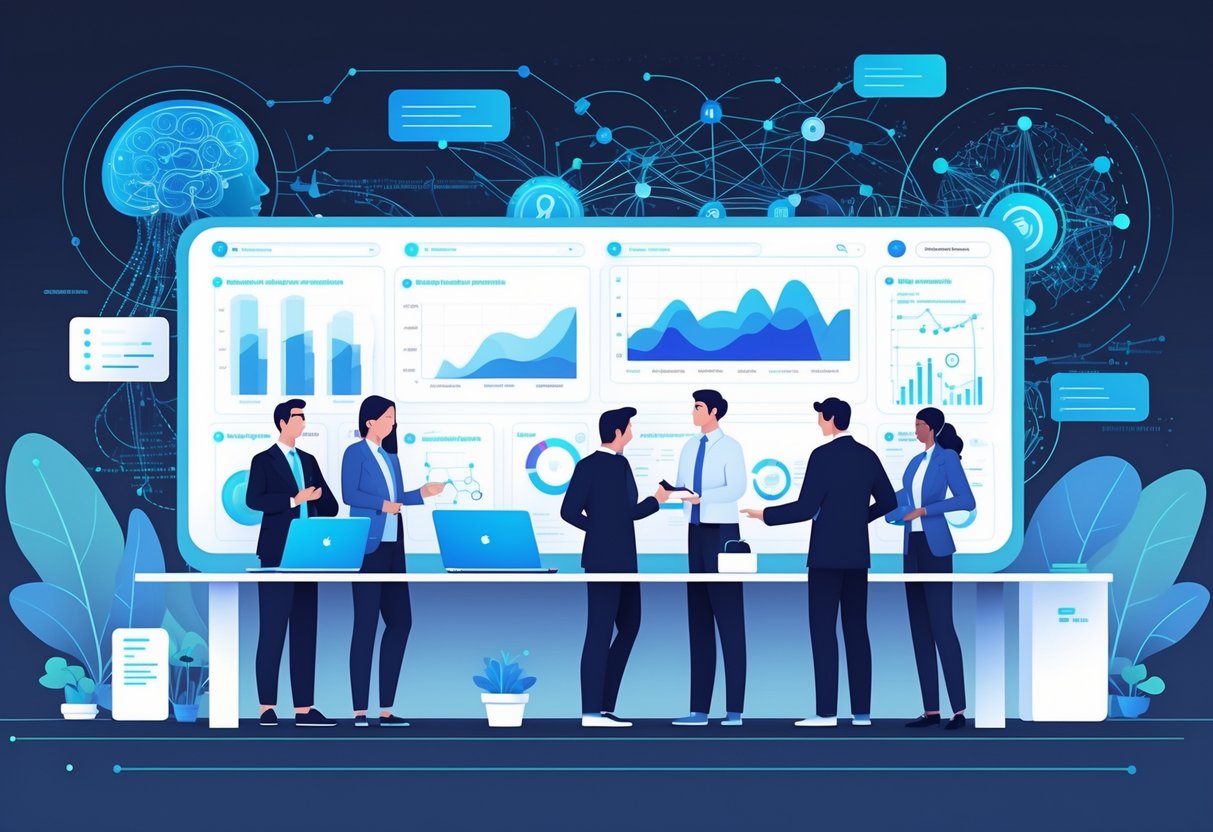
The best AI data assistants for analytics professionals in 2025 include Julius AI for conversational data analysis, Hex for collaborative workspaces, and ThoughtSpot for natural language queries, each offering unique capabilities to automate complex data tasks without requiring advanced technical skills. These tools can process data up to 100 times faster than traditional methods while providing predictive analytics and automated visualizations.
Modern AI assistants handle everything from data cleaning and preparation to creating interactive dashboards and generating reports. They integrate with existing data infrastructure and support multiple programming languages, making them valuable for both technical experts and business users who need quick access to data insights.
Key Takeaways
- AI data assistants automate repetitive analysis tasks and can process large datasets significantly faster than manual methods
- The top tools offer natural language interfaces that allow users to query data and generate insights without coding expertise
- Modern AI assistants provide end-to-end analytics capabilities including data preparation, visualization, predictive modeling, and automated reporting
What Are AI Data Assistants?
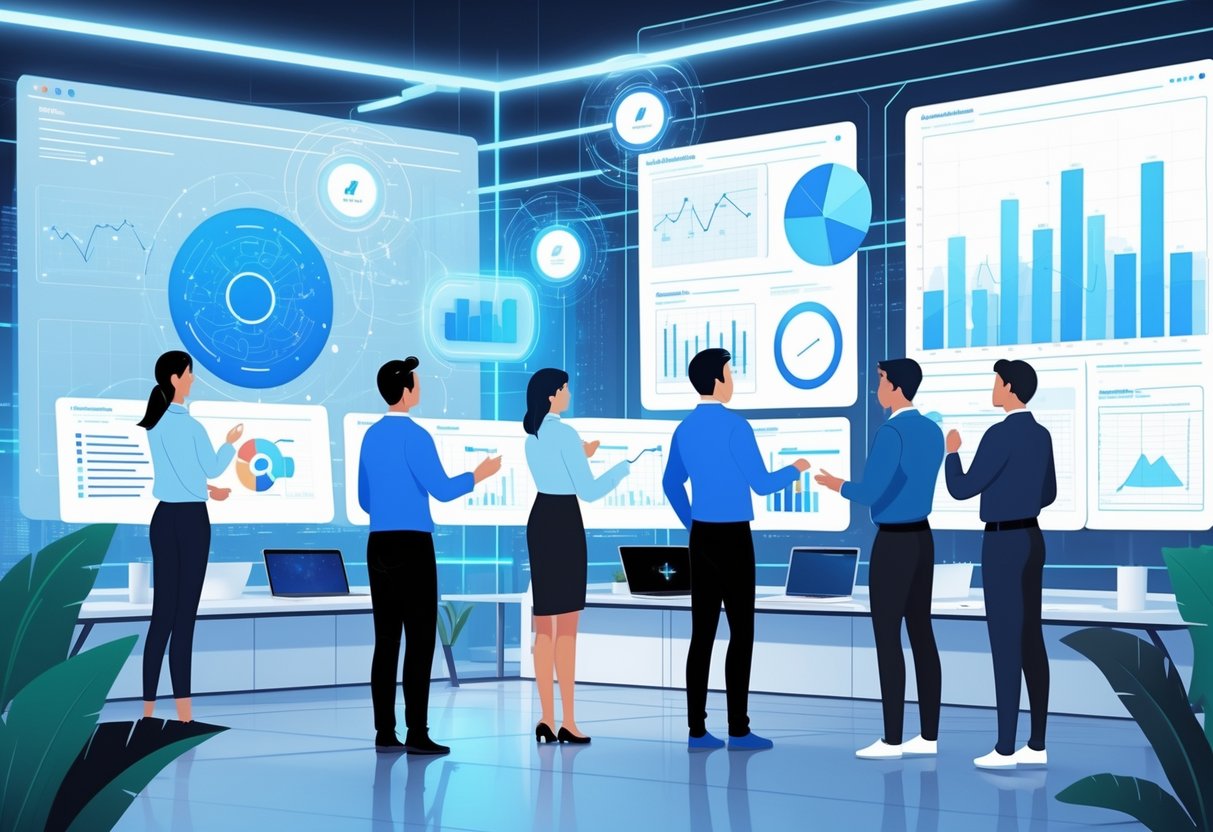
AI data assistants are specialized tools that use artificial intelligence to automate data analysis tasks through natural language interactions. These AI-powered tools combine machine learning algorithms with conversational interfaces to help professionals extract insights from complex datasets without requiring extensive coding knowledge.
Key Functions in Data Analysis
AI data assistants perform several critical functions that streamline the analytics workflow. They automate data cleaning by identifying and fixing format issues, typos, and inconsistencies across datasets.
Query Generation represents a core capability. These tools convert natural language questions into SQL queries or Python scripts. Users can ask “What were our sales trends last quarter?” and receive executable code.
Pattern Recognition allows AI assistants to identify hidden correlations and anomalies in large datasets. They scan millions of data points to surface meaningful trends that manual analysis might miss.
Visualization Creation happens automatically when users request insights. The AI generates appropriate charts, graphs, and dashboards based on the data type and query context.
Predictive Analytics capabilities enable forecasting future outcomes using historical patterns. AI-driven data analysis tools build regression models and time series forecasts without manual configuration.
Types of AI Data Assistants
Conversational Analytics Platforms like Julius AI and DataGPT focus on chat-based interactions. Users type questions in plain English and receive instant visualizations and insights.
Code-Generating Assistants such as Hex and Deepnote create SQL queries and Python scripts from natural language prompts. These tools bridge the gap between business questions and technical implementation.
Automated Insight Engines including ThoughtSpot’s Spotter proactively analyze data and deliver findings. They identify significant changes in metrics and explain the underlying causes.
No-Code Analytics Tools like DataSquirrel eliminate programming requirements entirely. Users upload spreadsheets and receive cleaned data with automated visualizations.
Enterprise Integration Platforms such as Dot connect with existing data warehouses and communication tools. They bring analytics capabilities directly into Slack, Teams, and other workplace applications.
Advantages Over Traditional Analytics Tools
Speed Enhancement stands as the primary benefit. AI tools for data analysis process queries up to 600 times faster than conventional business intelligence platforms.
Accessibility Improvements democratize data analysis across organizations. Non-technical users can perform complex analytics without learning SQL or statistical programming languages.
Natural Language Processing eliminates the learning curve associated with traditional tools. Large language models understand context, synonyms, and even typos in user queries.
Automated Quality Control reduces human error in data preparation and analysis. AI assistants validate results and prevent hallucinations through built-in evaluation frameworks.
Real-Time Collaboration features enable teams to share insights instantly. Multiple users can interact with the same datasets and build upon each other’s discoveries seamlessly.
Core Features of the Best AI Data Assistants
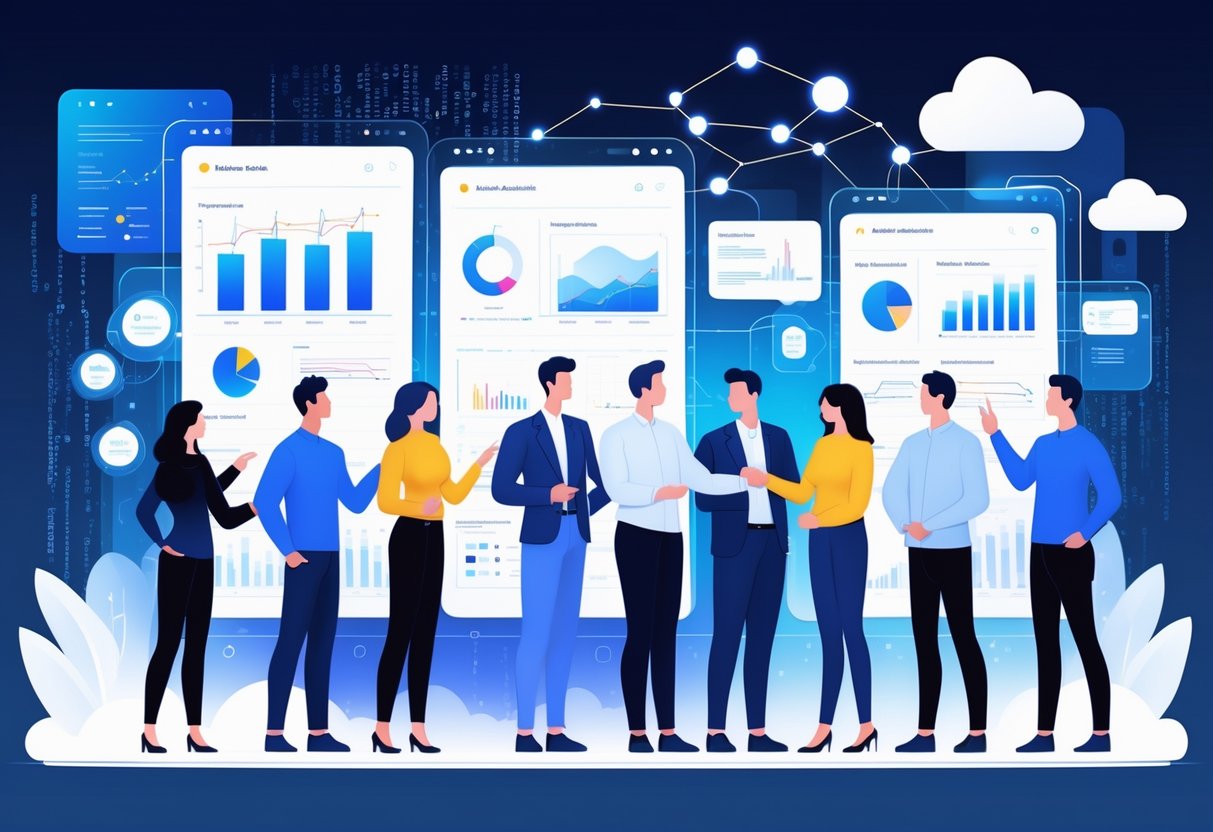
The most effective AI data assistants share several key capabilities that transform how analytics professionals work with data. These tools excel through intelligent automation that reduces manual tasks, natural language interfaces that make complex queries accessible, seamless integration with existing data ecosystems, and flexible customization options that scale with organizational needs.
Automation and Workflow Efficiency
Modern AI-powered analytics tools eliminate repetitive tasks that traditionally consume hours of analyst time. These systems automatically clean and prepare data, removing inconsistencies and formatting issues without manual intervention.
Automated Report Generation represents one of the most valuable features. AI assistants can schedule and create reports based on predefined parameters, updating stakeholders with fresh insights at regular intervals.
Data processing workflows become streamlined through intelligent automation. The systems detect patterns in user behavior and suggest optimization paths for common analytical tasks.
Key automation capabilities include:
- Automatic data quality checks and validation
- Scheduled dashboard updates and refreshes
- Intelligent alert systems for data anomalies
- Workflow templates for recurring analysis types
AI-driven automation also extends to predictive maintenance of data pipelines, identifying potential issues before they impact analysis workflows.
Natural Language Querying and Insights
Natural language processing transforms how users interact with complex datasets. Analytics professionals can ask questions in plain English rather than writing SQL queries or manipulating spreadsheet formulas.
Conversational Interfaces make data exploration intuitive. Users can request specific metrics, comparisons, or trend analysis using everyday language. The AI interprets intent and returns relevant visualizations or numerical results.
Tools like Zoho Analytics with Zia demonstrate this capability by allowing users to ask questions like “Show me sales trends for the last quarter” and receiving immediate visual responses.
Advanced natural language features:
- Context-aware query interpretation
- Multi-turn conversations for deeper analysis
- Automated insight generation from data patterns
- Voice-to-query functionality for hands-free operation
The technology recognizes business terminology and adapts to industry-specific language patterns, making queries more accurate over time.
Integration With Existing Analytics Ecosystems
Seamless connectivity with existing tools prevents data silos and maintains workflow continuity. The best AI assistants support hundreds of data connectors, linking databases, cloud platforms, and business applications.
Universal Data Access enables organizations to maintain their current infrastructure while adding AI capabilities. These tools connect to popular platforms like Salesforce, Google Analytics, Excel, and enterprise databases.
Microsoft Power BI exemplifies this approach by integrating with Azure, SharePoint, Dynamics 365, and other Microsoft services while supporting third-party connections.
Integration capabilities include:
- Real-time data synchronization across platforms
- API connectivity for custom applications
- Single sign-on authentication systems
- Cross-platform data governance and security
Data connectors maintain formatting consistency and handle authentication automatically, reducing technical barriers for non-technical users.
Customization and Scalability
Enterprise-grade AI assistants adapt to organizational needs through flexible customization options. Users can create custom dashboards, define specific metrics, and establish personalized alert systems.
Scalable Architecture ensures performance remains consistent as data volumes and user counts grow. Cloud-based solutions automatically allocate resources based on demand patterns.
Tools like H2O Driverless AI offer democratized AI capabilities that scale from individual analysts to enterprise-wide deployments without requiring extensive technical expertise.
Customization features:
- White-label options for client-facing reports
- Custom visualization templates and themes
- Personalized AI model training on organization data
- Role-based access controls and permissions
The systems learn from user preferences and organizational patterns, becoming more effective and relevant over time through machine learning optimization.
Top AI Data Assistants for Analytics Professionals in 2025

Modern analytics platforms now integrate advanced AI capabilities that automate data preparation, generate insights automatically, and create visualizations through natural language commands. These tools combine traditional business intelligence features with machine learning algorithms to help professionals analyze complex datasets more efficiently.
Tableau and Tableau Pulse
Tableau remains a leading visual analytics platform with enhanced AI features in 2025. The platform uses machine learning to suggest optimal chart types and automatically detect patterns in datasets.
Tableau Pulse represents the company’s AI-powered analytics assistant. It delivers automated insights and alerts directly to users’ workflows. The system monitors key metrics and sends notifications when significant changes occur.
Key AI Features:
- Smart recommendations for visualizations based on data types
- Natural language queries that convert questions into charts
- Automated anomaly detection across time series data
- Predictive modeling capabilities built into dashboards
The platform excels at handling large datasets from multiple sources. Users can connect to databases, cloud services, and spreadsheets simultaneously. This makes it valuable for analytics professionals who need comprehensive data integration.
Tableau’s AI assistant helps users discover hidden relationships in their data. It automatically generates explanations for trends and outliers. This saves analysts significant time during exploratory data analysis phases.
Microsoft Power BI
Power BI offers robust AI integration through its Copilot feature and automated machine learning capabilities. The platform connects seamlessly with other Microsoft products like Excel and Azure.
The AI assistant can create DAX formulas automatically based on natural language descriptions. Users describe what they want to calculate, and the system generates the appropriate code. This reduces the technical barrier for business users.
Core AI Capabilities:
- Q&A visual that answers questions in plain English
- Quick insights feature that scans data for patterns
- AutoML integration for predictive analytics
- Smart narrative that explains chart findings
Power BI’s anomaly detection works across multiple data streams simultaneously. It identifies unusual spikes, drops, or changes in business metrics. The system provides context about why these anomalies might have occurred.
The platform’s integration capabilities make it particularly strong for organizations already using Microsoft’s ecosystem. Data flows smoothly between Excel, SharePoint, and Power BI without manual intervention.
Polymer
Polymer focuses on making advanced analytics accessible to non-technical users through AI automation. The platform transforms spreadsheets into interactive dashboards without requiring coding skills.
Users upload CSV files or connect databases, and Polymer’s AI automatically suggests visualizations. The system identifies the most relevant charts based on data patterns and relationships between variables.
Standout Features:
- Automatic data cleaning that handles missing values and formatting issues
- AI-generated insights that explain what the data shows
- No-code dashboard creation with drag-and-drop interface
- Collaborative sharing with team members and stakeholders
The platform excels at rapid prototyping for data exploration. Analytics professionals can quickly test hypotheses and share findings with business stakeholders. The AI assistant provides explanations in simple language that non-technical audiences understand.
Polymer’s strength lies in its simplicity and speed. Complex analyses that traditionally required hours of setup can be completed in minutes. This makes it valuable for teams that need quick turnaround times on ad-hoc requests.
Akkio
Akkio specializes in predictive analytics with a focus on business forecasting and classification tasks. The platform uses automated machine learning to build models without requiring data science expertise.
Users can predict customer behavior, sales trends, and operational outcomes by simply uploading historical data. The AI automatically selects appropriate algorithms and optimizes model parameters for best performance.
Primary Strengths:
- Automated feature engineering that improves model accuracy
- Real-time predictions through API integrations
- Model explainability that shows which factors drive predictions
- Easy deployment to production environments
The platform handles common business use cases like churn prediction, demand forecasting, and lead scoring. Its AI assistant guides users through the model building process with clear recommendations at each step.
Akkio’s automated approach removes technical complexity from predictive modeling. Analytics professionals can focus on interpreting results and making business recommendations rather than tuning algorithms. The system provides confidence scores and explanations for each prediction to support decision-making.
Specialized AI Tools and Platforms
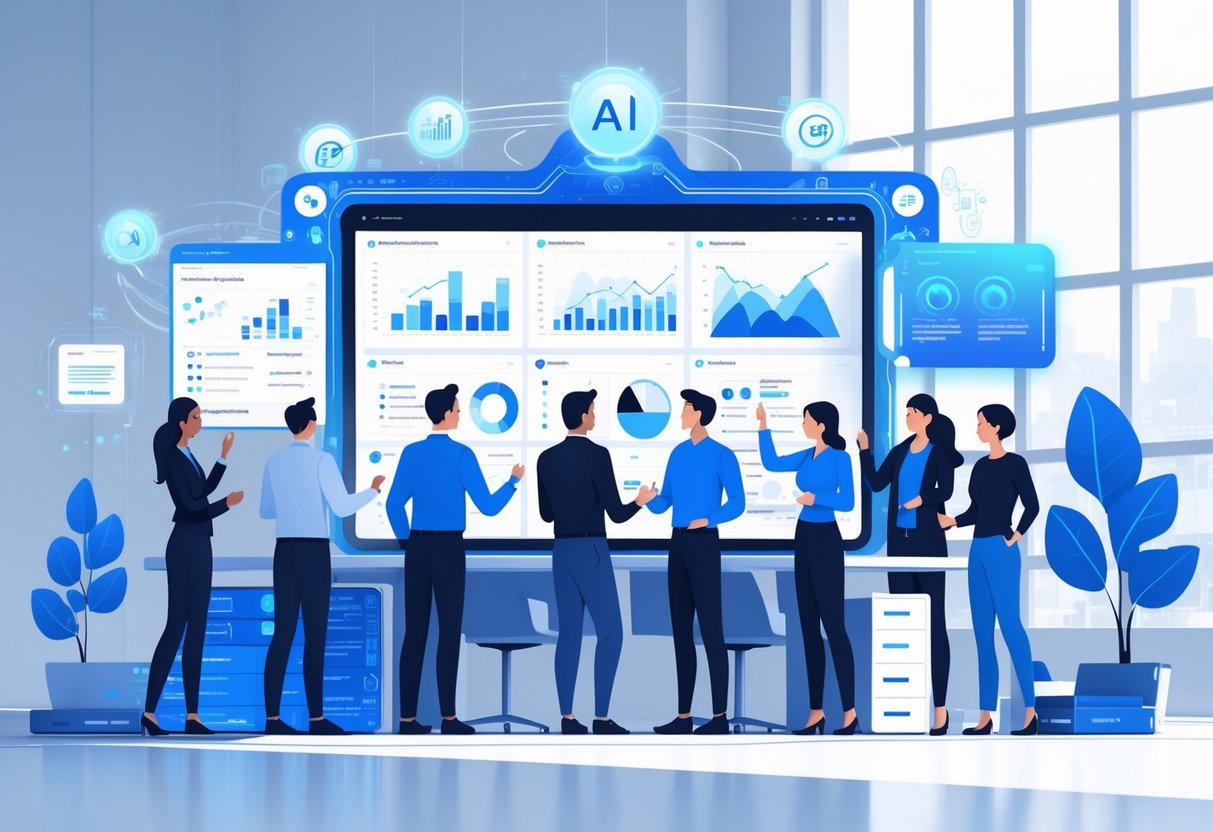
These enterprise-grade platforms combine advanced machine learning capabilities with visual workflow design and automated model deployment. Each platform targets specific aspects of the analytics workflow, from drag-and-drop data preparation to scalable cloud-based processing.
KNIME
KNIME offers open-source data analytics with a visual workflow approach that eliminates coding requirements for many tasks. The platform uses a node-based system where analysts drag and drop components to build data pipelines.
Key Features:
- Visual workflow designer with 2,000+ nodes
- Integration with R, Python, and Scala
- Machine learning algorithms built-in
- Community extensions and shared workflows
The platform excels at data preparation and preprocessing tasks. Analysts can clean, transform, and merge datasets from multiple sources without writing code.
KNIME supports both batch and streaming data processing. The platform handles structured and unstructured data from databases, files, and web services.
Best Use Cases:
- Pharmaceutical research and drug discovery
- Financial risk modeling
- Manufacturing quality control
- Academic research projects
Qlik
Qlik provides associative analytics that reveal hidden relationships in data through its unique in-memory processing engine. The platform automatically creates associations between data points across different tables and sources.
Core Capabilities:
- Associative data model
- Natural language query processing
- Automated insight generation
- Mobile-responsive dashboards
The associative engine differs from traditional query-based systems. Users can click on any data point to see related information across all connected datasets instantly.
Qlik Sense offers self-service analytics with drag-and-drop chart creation. Business users can explore data independently without IT support for basic analysis tasks.
Primary Applications:
- Sales performance tracking
- Supply chain optimization
- Customer behavior analysis
- Financial planning and budgeting
DataRobot
DataRobot automates the entire machine learning lifecycle from data preparation through model deployment and monitoring. The platform tests hundreds of algorithms automatically to find the best-performing models for specific datasets.
Automation Features:
- Automated feature engineering
- Model selection and tuning
- Bias detection and fairness testing
- Production deployment monitoring
The platform provides explainable AI capabilities that show how models make predictions. This transparency helps analysts understand model behavior and meet regulatory requirements.
DataRobot handles time series forecasting, classification, and regression problems. The platform supports both structured data and unstructured text analysis.
Target Industries:
- Healthcare predictive modeling
- Financial fraud detection
- Marketing campaign optimization
- Insurance risk assessment
Databricks
Databricks creates unified analytics workspaces built on Apache Spark for large-scale data processing. Data scientists, engineers, and analysts collaborate in shared notebooks with real-time co-authoring capabilities.
Platform Strengths:
- Spark-based distributed computing
- MLflow for model lifecycle management
- Delta Lake for reliable data storage
- Auto-scaling cluster management
The platform handles both streaming and batch data processing at petabyte scale. Organizations use Databricks for real-time analytics and large-scale ETL operations.
Integration with cloud providers Amazon Web Services, Microsoft Azure, and Google Cloud Platform provides flexible deployment options. The platform manages infrastructure automatically while users focus on analysis tasks.
Common Applications:
- Real-time recommendation engines
- IoT sensor data processing
- Large-scale A/B testing
- Regulatory compliance reporting
AI Assistants for Predictive Analytics and Modeling

Modern AI assistants transform how analytics professionals build predictive models and extract forecasting insights from data. These tools automate complex machine learning workflows while providing real-time analysis capabilities that accelerate decision-making processes.
Predictive Modeling Capabilities
AI assistants streamline the entire predictive modeling process through automated feature engineering and model selection. H2O.ai provides automated machine learning capabilities that handle feature engineering, model selection, tuning, and validation with minimal configuration.
DataRobot stands out for its comprehensive AutoML approach. The platform automatically tests multiple algorithms and selects the best-performing models for specific datasets.
These tools reduce model development time from weeks to hours. They handle data preprocessing, feature selection, and hyperparameter tuning automatically.
Key predictive modeling features include:
- Automated algorithm selection
- Feature engineering automation
- Model validation and testing
- Performance optimization
- Cross-validation capabilities
Analytics professionals can focus on interpreting results rather than manual model construction. This acceleration proves especially valuable for time-sensitive business forecasting needs.
Machine Learning Model Integration
AI assistants seamlessly integrate with existing machine learning frameworks and enterprise data systems. DataRobot offers native support for tabular, time series, text, and image data with cloud-native deployment options.
Modern platforms connect with popular ML libraries like scikit-learn, TensorFlow, and PyTorch. They also integrate with business intelligence tools and data warehouses.
Integration capabilities typically include:
- REST API connections
- Python and R support
- Cloud platform compatibility
- Database connectivity
- Model versioning systems
Databricks Lakehouse AI combines Apache Spark with MLflow for unified machine learning workflows. This integration allows teams to move from raw data to production-ready AI models within a single platform.
The unified approach eliminates data silos and reduces deployment complexity for predictive AI solutions.
Real-Time Data Analysis
AI assistants enable continuous model monitoring and real-time predictive insights from streaming data sources. TIBCO Spotfire supports real-time analytics through TIBCO Data Streams for IoT and live system monitoring.
These tools process incoming data streams and update predictions automatically. They detect model drift and performance degradation in production environments.
Real-time analysis features include:
- Stream processing capabilities
- Automated alerting systems
- Model drift detection
- Performance monitoring
- Dynamic model updating
Analytics professionals receive immediate notifications when model accuracy declines or data patterns change. This proactive approach maintains prediction quality over time.
The combination of real-time processing with predictive modeling enables businesses to respond quickly to changing market conditions and operational challenges.
Data Preparation: Cleaning, Processing, and Exploration

AI assistants automate data cleaning tasks like removing duplicates and handling missing values. They streamline processing workflows through visual interfaces and enable rapid exploratory analysis with automated insights.
Automated Data Cleaning
Modern AI tools eliminate manual data cleaning tasks that consume hours of analyst time. Trifacta Wrangler uses machine learning to suggest data transformations and automatically detect inconsistencies in datasets.
Alteryx provides a code-free environment where analysts can clean data through drag-and-drop operations. The platform identifies data quality issues and suggests fixes without requiring programming knowledge.
Data preparation tools offer visual query builders that make cleaning accessible to non-technical users. These interfaces show data transformations in real-time as analysts apply changes.
Key automated cleaning features include:
- Duplicate record detection and removal
- Missing value imputation using statistical methods
- Outlier identification through machine learning algorithms
- Data type standardization across columns
Data Processing Workflows
AI-powered platforms create reusable workflows that transform raw data into analysis-ready formats. KNIME builds modular data pipelines where each step connects visually to show the complete process.
RapidMiner offers automated machine learning capabilities that handle data processing steps automatically. Users can build complex workflows without writing code while maintaining full control over each transformation.
These platforms integrate with existing data infrastructure and support various data sources simultaneously. Analysts can combine database tables, spreadsheets, and API feeds in single workflows.
Processing workflow benefits:
- Scalability: Handle datasets from thousands to millions of records
- Repeatability: Save workflows for consistent data preparation
- Integration: Connect multiple data sources seamlessly
Exploratory Data Analysis (EDA)
AI assistants accelerate data exploration by automatically generating statistical summaries and visualizations. IBM Watson Analytics uses natural language processing to answer questions about datasets in plain English.
Tableau creates interactive dashboards that reveal patterns through drag-and-drop functionality. Analysts can explore relationships between variables without building complex queries.
Google Cloud AI Platform provides automated insights that highlight significant trends and correlations in datasets. The platform suggests relevant visualizations based on data types and distributions.
Advanced EDA capabilities include:
- Correlation matrices showing variable relationships
- Distribution plots revealing data patterns
- Anomaly detection highlighting unusual observations
- Statistical testing for hypothesis validation
These tools transform hours of manual exploration into minutes of automated analysis.
Data Visualization and Reporting With AI

AI transforms raw data into clear visual stories through automated chart generation and intelligent reporting systems. Modern AI assistants can create interactive dashboards, generate reports automatically, and apply advanced visualization techniques that adapt to different data types and user needs.
Interactive Dashboards
AI-powered dashboards respond to natural language queries and update visualizations in real-time. Users can ask questions like “show me sales trends by region” and receive instant visual answers without writing code.
Top AI data visualization tools now support drag-and-drop interfaces that automatically suggest the best chart types for specific datasets. These systems analyze data structure and recommend visualizations that highlight key patterns.
Key Interactive Features:
- Real-time data filtering and sorting
- Click-through drill-down capabilities
- Responsive design for mobile and desktop
- Collaborative sharing with role-based permissions
Modern platforms like Julius AI integrate multiple language models including GPT-4 and Claude 3.5 to provide specialized analysis workflows. Users can switch between different AI models depending on their specific visualization needs.
The best AI dashboards connect to over 500 data sources simultaneously. This eliminates the need to manually import and export files between different systems.
Automated Reporting
AI assistants generate comprehensive reports from raw data without human intervention. These systems identify trends, anomalies, and insights then format them into professional documents.
Automated Report Components:
- Executive summaries with key metrics
- Trend analysis with statistical significance
- Anomaly detection and alerts
- Predictive forecasting charts
AI-powered tools for data visualization can schedule reports to run daily, weekly, or monthly. The AI learns from user feedback to improve future report quality and relevance.
Smart reporting systems adapt their format based on the audience. Technical reports include detailed methodology while executive summaries focus on business impact and recommendations.
These tools export reports in multiple formats including PDF, PowerPoint, and interactive web pages. Users can customize templates to match company branding and style guidelines.
Advanced Data Visualization Techniques
AI enables complex visualization methods that were previously difficult to create manually. Machine learning algorithms identify the most effective visual encoding for different data types and relationships.
Advanced Techniques Include:
- 3D interactive visualizations with zoom and rotation
- Animated charts showing data changes over time
- Network diagrams for relationship mapping
- Geospatial analysis with heat mapping
Modern AI visualization platforms support both static images and interactive HTML exports. Users can create animated GIFs that show data evolution or embed interactive charts directly into websites.
AI assistants automatically adjust color schemes for accessibility and readability. They consider factors like color blindness and contrast ratios when generating visualizations.
The most sophisticated tools combine multiple visualization types into cohesive dashboards. AI determines optimal layout and sizing to maximize information density while maintaining clarity.
Choosing the Right AI Data Assistant for Your Workflow
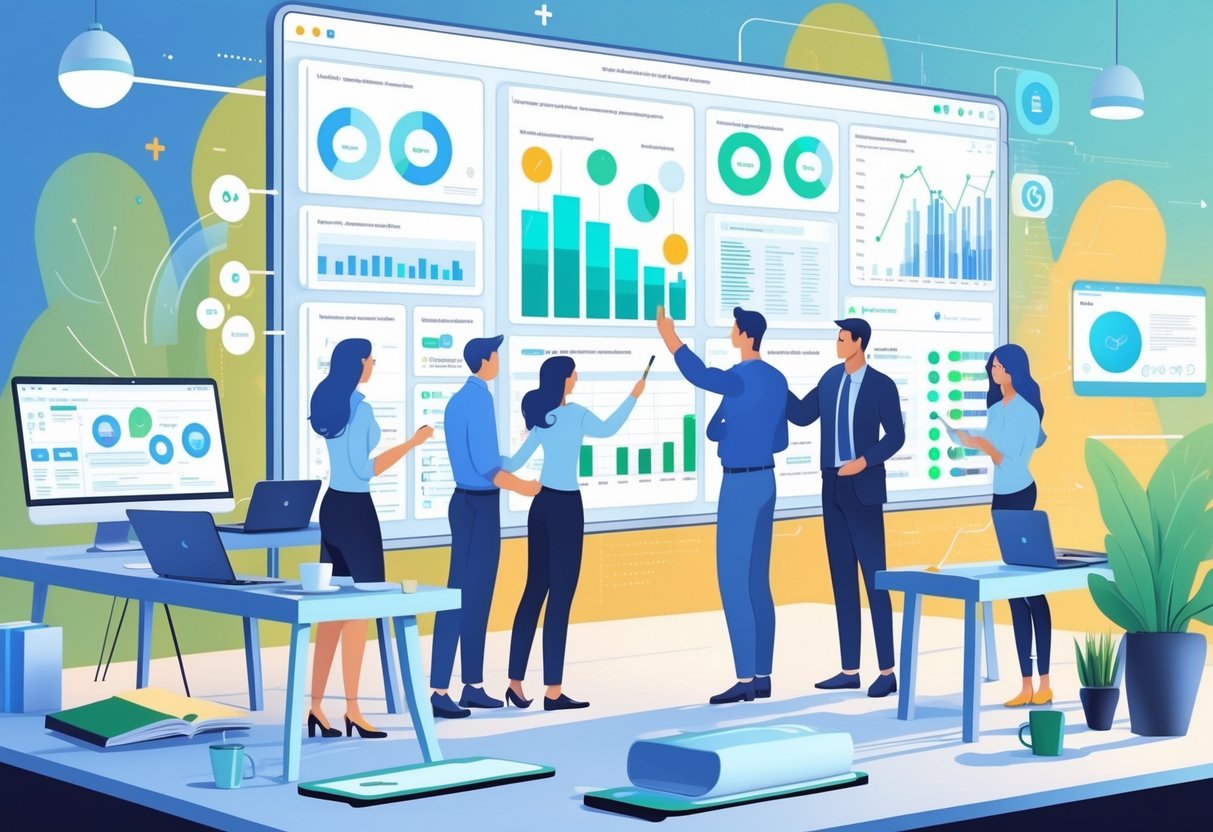
The right AI data assistant depends on your specific needs, technical skills, and existing tech stack. Key factors include integration capabilities with tools like Python and SQL, budget constraints, and whether you need real-time processing or basic analysis features.
Factors to Consider
Budget and licensing play a major role in tool selection. Free options like ChatGPT’s advanced data analysis work well for basic tasks, while enterprise platforms offer more robust features at higher costs.
Technical expertise determines which tools will work best. Analysts comfortable with Python and R can leverage more advanced platforms. Those preferring point-and-click interfaces should focus on visual tools.
Data security requirements matter especially for regulated industries. Some tools process data locally while others send information to cloud servers.
Real-time processing needs separate basic from advanced tools. Some tools handle live data connections to sources like Snowflake, while others work only with static files.
Integration complexity affects workflow efficiency. Tools that connect easily to existing business intelligence platforms reduce setup time and training needs.
Tool Comparison by Use Case
Excel-heavy workflows work best with Microsoft Fabric. It allows natural language queries on spreadsheets and syncs results back to Excel without file exports.
Python developers benefit from Jupyter AI and Google Colab. These platforms provide AI-powered code suggestions and automated data insights generation within familiar notebook environments.
Real-time analytics requires specialized tools that connect directly to live data sources like Snowflake and provide instant answers through natural language queries.
Quick exploratory analysis suits ChatGPT’s GPT-4 capabilities. Upload CSV files and get immediate visualizations and summaries without coding knowledge.
Enterprise teams often choose Databricks Mosaic for its integration with existing data infrastructure and advanced SQL processing capabilities.
Integration With Coding Languages and Platforms
Python integration varies significantly across tools. PandasAI works directly with pandas dataframes, while Hugging Face models require more setup but offer greater customization options.
SQL connectivity determines data access capabilities. Advanced platforms connect to databases like Snowflake and PostgreSQL for live querying. Basic tools require data exports first.
R language support remains limited in most AI assistants. Analysts using R often need to export results to compatible formats or use specialized academic tools.
API accessibility enables custom integrations. Tools with robust APIs allow teams to build custom workflows and connect to internal systems more easily.
Cloud platform compatibility affects deployment options. Some tools work best within specific ecosystems like Google Cloud or Microsoft Azure, while others remain platform-agnostic.
The Future of AI in Analytics

AI in data analysis is transforming how organizations process information and make decisions. Large language models are revolutionizing data analytics by enabling natural language interactions with complex datasets, while generative AI creates new possibilities for automated insight generation.
Emerging Trends in AI-Driven Analytics
Multi-agent systems are becoming the standard for complex data analysis tasks. AI agents collaborate autonomously to handle different aspects of analysis, from data cleaning to visualization.
These systems simulate teams of specialists working together. One agent finds data patterns while another generates reports. A third agent checks the work for accuracy.
Real-time autonomous analysis is replacing traditional batch processing. AI systems now monitor data streams continuously and alert analysts to important changes immediately.
Cross-platform integration allows AI tools to work with multiple data sources simultaneously. Modern AI data analysis tools connect databases, spreadsheets, and cloud platforms without manual intervention.
Predictive capabilities are advancing beyond simple forecasting. AI now identifies potential problems before they occur and suggests specific actions to prevent them.
Role of LLMs and Generative AI
Large language models transform how data analysts interact with their tools. Users can now ask questions in plain English instead of writing complex SQL queries or Python code.
Natural language interfaces eliminate technical barriers. An analyst can type “show me sales trends for the past quarter” and receive instant visualizations with explanations.
Code generation speeds up analysis workflows significantly. Generative AI creates SQL queries, Python scripts, and visualizations from simple text prompts, reducing development time from hours to minutes.
Automated documentation helps teams understand analysis results better. AI generates clear explanations of methodologies, assumptions, and limitations for each analysis.
Context awareness allows LLMs to remember previous conversations and build on earlier work. This creates more intelligent and efficient analytical workflows.
Democratizing Data Analysis for All Users
AI removes the technical skills barrier that previously limited data analysis to specialists. Business users can now perform sophisticated analysis without programming knowledge.
No-code platforms enable anyone to upload data and ask analytical questions. Tools now allow users to interact with datasets using natural language without any coding requirements.
Automated insight generation identifies important patterns automatically. Users receive alerts about anomalies, trends, and opportunities without manually searching through data.
Self-service analytics reduces dependency on technical teams. Marketing managers can analyze campaign performance, while sales directors can track regional trends independently.
Educational guidance helps users learn analytical concepts through AI tutoring. The systems explain statistical methods and help users understand when to apply different techniques.
Frequently Asked Questions
Analytics professionals often have specific questions about AI data assistants and their capabilities. These tools offer varying levels of automation, visualization features, and integration options that can significantly transform how businesses handle data analysis tasks.
What are the top-rated AI data assistants for enhancing analytics workflows?
LAMBDA stands out as a cutting-edge framework that allows users to interact with data using plain English. The system uses multiple AI agents working together to analyze uploaded datasets without requiring coding knowledge.
LangChain provides a powerful open-source framework for building custom AI agents that can chain multiple components together. It integrates with APIs, databases, and cloud tools to solve complex data analysis problems.
Microsoft AutoGen enables multi-agent AI systems where specialized agents collaborate on different tasks. Each agent can handle specific roles like data analysis, code execution, or reporting.
Which AI data assistant offers the best data visualization capabilities for professionals?
AgentBuilder.ai provides drag-and-drop functionality for creating custom AI agents without coding experience. Users can upload various file types and embed agents into websites or internal dashboards.
LangChain offers integration capabilities with visualization tools and APIs. The framework supports memory and document indexing that can enhance visual data presentation.
DeepSeek Agent supports multi-modal inputs including charts and visual data formats. It can process text, code, PDFs, and charts for comprehensive analysis workflows.
How do AI data assistants impact overall data analysis efficiency in a business setting?
AI assistants make data analytics accessible even for inexperienced users through natural language processing chatbots. Non-technical personnel can analyze complex datasets at a professional level with minimal training.
These tools have become indispensable for businesses of all sizes by offering sophisticated capabilities that were once limited to data science teams.
The automation of routine tasks allows analytics professionals to focus on strategic insights rather than manual data processing. Multi-agent systems can handle data cleaning, analysis, visualization, and reporting simultaneously.
What features differentiate the leading AI assistants for data analytics available today?
LAMBDA uses a multi-agent conversation system internally with roles like Data Finder and Insight Generator working together. This approach provides detailed and interpretable responses to follow-up questions.
BabyAGI offers autonomous task generation and execution with embedded vector databases for long-term memory. The system can reprioritize tasks and learn from previous results.
Convergence AI Proxy 1.0 performs human-like web interactions by browsing websites and gathering real-time data. It can click links, submit forms, and scrape content autonomously.
Can AI data assistants provide robust support for research-related activities in analytics?
DeepSeek Agent excels at autonomous task decomposition and long-context reasoning workflows. It integrates web browsing, file parsing, and code execution for comprehensive research tasks.
Meta AutoGPT-style agents can perform entire research tasks from start to finish with minimal human input. They decompose objectives, retrieve data, and iterate until goals are reached.
BabyAGI creates iterative learning loops that refine outputs over time. The system generates tasks, prioritizes them, and executes them autonomously for continuous research workflows.
What are the commonly recommended AI tools for data analysis according to industry experts?
Industry testing reveals significant variations in AI assistant performance across different data analysis tasks. Experts recommend evaluating tools based on specific use cases and scalability requirements. For those interested in practical learning and hands-on experience with data analysis and AI tools, consider exploring the Analytics Engineering Practice Exercises and Premium Projects.
Open-source frameworks such as LangChain and AutoGen are frequently recommended for custom development needs. These platforms offer flexibility for building tailored AI pipelines.
No-code solutions are commonly suggested for teams seeking quick deployment without engineering resources. For a curated selection of tools and exercises to enhance your AI data analysis skills, visit the Analytics Engineering Games Selection and Practice Quizzes. These resources bridge the gap between AI capabilities and everyday workflows.




